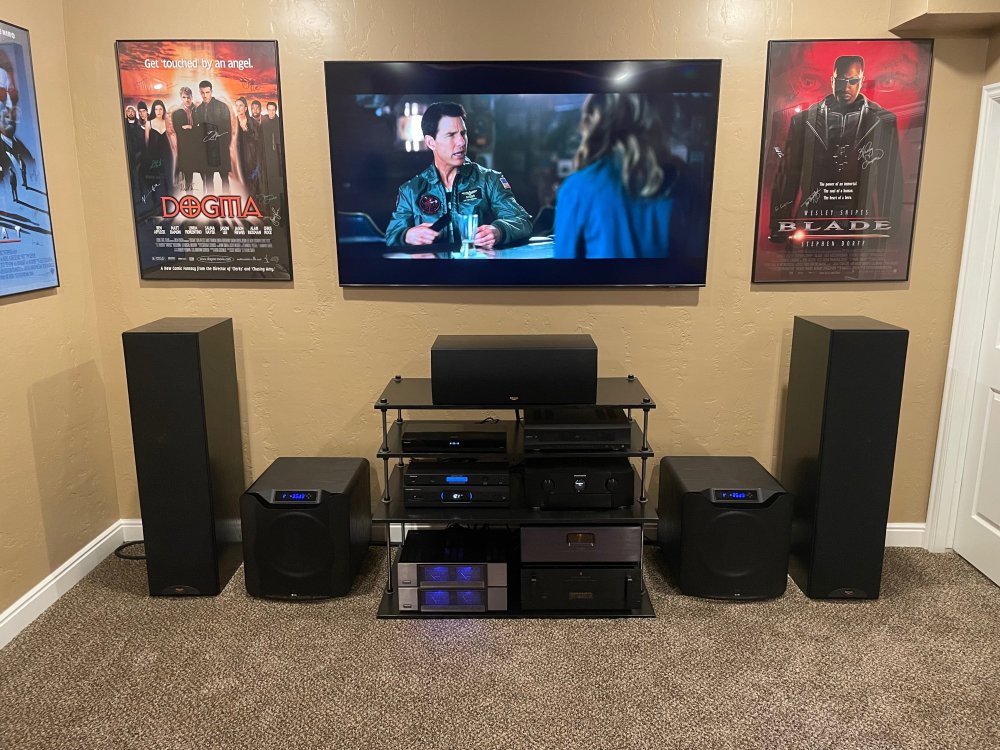-
Posts
6,906 -
Joined
-
Last visited
-
Days Won
252
Daddyjt last won the day on November 5
Daddyjt had the most liked content!
About Daddyjt
- Birthday March 6
Community Information
-
Member Title
The One
Personal Information
-
Gender
Male
-
Location
Utah
-
RealName
Mark
-
Occupation
ATF Compliance Manager (keeping my company one step ahead of the ATF!)
Recent Profile Visitors
17,959 profile views
Daddyjt's Achievements
-
Thanks for the kind words my friend. During Tim’s visit, we sat down in the theater room for a quick demo. I put in the 4k disc of the new Brad Pitt movie, F1. What was going to be a quick demo turned in to watching the entire movie…:-)
-
I was discussing my bass journey and current status of my HT on a popular home theater forum when something kinda weird happened. A guy named Scott Newbey chimed in. He’s a self-proclaimed “bass expert” with a cult following similar to Amir’s over on ASR. Anyway, this Scott guy commented on my system and said that I could get way more bass with just a dual 18” ported sub from GSG, pairs with a Crown amp, and that I was “wasting my time with sealed subs in a home theater”. i replied tactfully and directly that I wasn’t looking for “the most” bass, but rather “the best” bass. This didn’t sit well with the bass guru, and he marshaled his minions to his defense. I don’t really care, and I am a firm believer in the accuracy and speed of sealed subs. Sure, ported subs have prodigious output at the tuned frequency, but well designed sealed subs just make me smile at all low frequencies….
-

Just a simple introduction to the "Old Man"
Daddyjt replied to Old Man's topic in The Welcome Shop (Please read first)
Welcome. We’re almost all old(ish) guys here, so you’ll fit right in! -
Ah, Polk LS70s - my first “real” pair of speakers, bought new from Broadway Music in downtown SLC about 1995. They were in my first home theater (such as it was), and then when they were displaced by Klipsch RF7s, they served in my family room system until about 2018. I just recently sold them to a kid on the local classifieds for $100. They were a little rough cosmetically, but still sound great - he was thrilled, as he’s starting a family and tight on money. He’s actually texted me a few times, saying how much he loves them. welcome to the site!
-

Greetings from Wild, Wonderful WV
Daddyjt replied to mwc951's topic in The Welcome Shop (Please read first)
I have worked on (and purchased) equipment that has been restored/refreshed by “other” techs, two pieces of which came with invoices. I will tell you flat out that not only were the prices WAY out of line, the actual work done did not align with the invoice. Greg at Nelion will do exactly what he claims, and at a fair price. Further, there is no tech currently that understands Bob’s designs better than Greg. -

New to the site and to Carver m500
Daddyjt replied to clstuff's topic in The Welcome Shop (Please read first)
I have owned, upgraded and repaired a number of Carver M 500(t) amplifiers. It is, dollar for dollar the best value in Carver amplifiers, in my opinion. They sound wonderful, are quite reliable, easy to work on, and have a beautiful aesthetic. Perhaps their only (minor) Achilles Heel is low impedance loading. Even that though is very limited, as the only speaker I ever had thermal issues with while using a 500t were my Infinity Kappa 9 (notorious amp killers), and even then, the thermal protection did its job, and spared the amplifier any damage. i am currently running a pair of 500t MKII amplifiers in my home theater for L/R/C duty… -
Sounds like the power supply caps have given out (not uncommon at this age). James ( @Retriever ) is very knowledgeable on these units.
-
The completed frame is quite light, allowing it to be positioned and mounted to the wall. Take care to make sure it is both level AND square when mounting! Once it is mounted, populate the shelves to the desired height. One of the only potential annoyances with this system is this: If a shelf is positioned such that the 1”x2” wall support is contacting the upper half of your media, it will allow for the bottom portion of your media to push in farther than the top, where it is contacting the 1”x2”. In this case, simply cut a spare 1x2 to the width of your shelf and lay it at the bottom/back of the shelf, so that the media contacts a 1x2 on the top and bottom. This shelf is for my growing 4k collection (and Atmos music). You can see below, my old 4k storage (far right of frame) was almost full. On the new shelving, I’m only about 1/2 full. Oh, and I already use one (1) of the two (2) extra shelves I built;-)
-
After the second coat of polyurethane has dried, a second steel wool treatment with fine (000 or 0000) and another tac cloth rub. Now that all the wood cutting and finishing is done, it’s time for construction. The key to the strength of this build lies here - the 1”x2” mounting boards are screwed into the notches in the vertical supports FROM THE BACK SIDE, before the unit is mounted to the wall, then the entire assembly (sans shelves) is mounted to the wall.
-
With sanding done, SWEEP UP YOUR WORK AREA! This will minimize kicking up dust and particles during the finishing process. I like to hit all surfaces with the air compressor to blow off as much dust as possible. This also gets dust out of the grain, which will really make the grain stand out when stained/finished. After the compressor treatment, a tac cloth is a good idea, right before finishing. For this project, I’m not using a stain, just a satin polyurethane finish. For a project like this, I just use a foam brush and toss it when done. Long strokes with the grain, and careful to avoid drips/sags… 24 hours (depending on temp/humidity - but if ANY tac remains, WAIT!) later, a good rubbing with semi-coarse steel wool is essential to smooth the wood down. DO NOT use steel wool if using a water-based finish!! After steel wool, tac cloth again and another coat of polyurethane.
-
Next is perhaps the most precise part of construction - the cutting of the 1”x2” notches in the vertical supports. It is critical that they be cut in the exact same place on all verticals supports being made for a continuous run, or it will be impossible to have level shelves. For these reasons, I stack the vertical supports and cut them at the same time. Next up is sanding. DO NOT skimp on sanding! It takes a bit of time, but few things can make or break a project quite like sanding (or lack thereof). I do a full pass with 120 on the random orbital, then a pass with the 1/3 sheet at 180, then a final pass with 220 on the 1/3 sheet. I like the random orbital on initial passes, but not for the final.
-
Next is cutting the individual shelves. In my case, I want 42” overall width, so subtracting the 3/4” (x2) for the side panels gives me 40.5”. Cut and build a couple more shelves than you think you’ll need! You already have everything out - just make a couple extras, as you never know what your future needs will be. You’ll thank me later. Also cut your 1”x2” to the overall width (42” for this one) and all the screen molding for the exposed edges. There are a couple different ways to mount the screen molding to the edges. Glue and clamp, clue and finish nail (with nail-set and wood putty), or glue and pin nail with an air nailer - this is the method I use.
- 16 replies
-
- 10
-

-

-
Work these two strips together and symmetrically, so that your shelves will be level. I mark the top of each, and start my holes at the exact same height. The bit included with the jig has an adjustable stop collar - set it to the correct depth and drill the starter hole at the top. Then position the jig with the included pin and drip the remaining holes. Move the jig down, place the pin and repeat. It’s not near as monotonous as it sounds, and it goes pretty fast.
-
Step one is to source a sheet of 3/4” oak plywood (or whatever wood you prefer), screen molding and 1”x2”. I must say, I was shocked at the increase in oak plywood pricing - last time I bought it I remember paying around $40 a sheet. No so any more - try $96 a sheet! Anyway, accounting for the 1/4” thickness of the screen molding on the edge, rip the plywood into 5.75” strips to achieve the 6” overall depth. Next, cut 2 (or more) of the strips to the overall height you desire for your shelving unit - in my case, for this unit I’m going with 60” (Al the other shelving in my room is 96”, or the full 8’). These will be the vertical or side supports. In order to make the shelving fully adjustable, these need to have a series of holes drilled for the shelf support pegs. These hole need to be perfectly spaced, drilled perfectly perpendicular, and be a perfect consistent depth on BOTH boards. Luckily, Kreg makes a jig for this that is quite affordable and easy to use…
-
About 15 years ago I ran out of space in the five (5) bookcases I was using for CD/DVD storage. I figured there had to be a better way, and after a bit of thinking, I came up with it. On-wall, only 6” deep, adjustable shelf height, and inexpensive and easy to build. With the expansion of my library into 4k discs, I am adding a 60”x42” chunk of the shelving In my current media room (6’ X 8’ walk in closet). I thought I’d document the construction process here, for anyone that may wish for a similar storage solution. The system itself consists of 1”x2” mounting rails (x2), and 6” strips of 3/4” oak plywood with screen molding to cover the edge for the vertical supports and the individual shelves. I’ve included a few photos below from my original build, but I’ll do a thorough step-by-step with the current build.
- 16 replies
-
- 11
-

-




















































